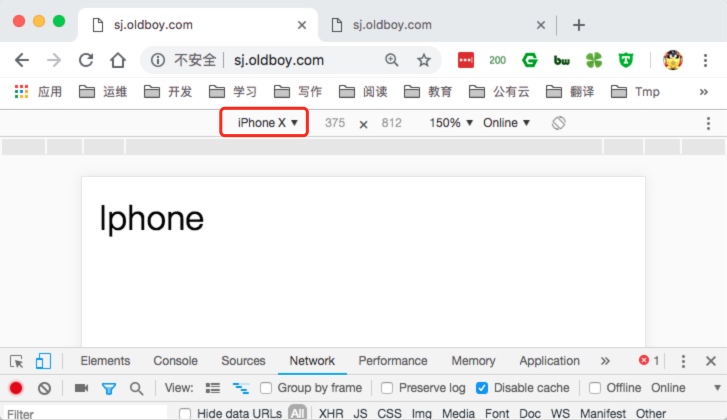1.Nginx动静分离基本概述
动静分离, 通过中间件将动静分离和静态请求进行分离。
那为什么要通过中间件将动态请求和静态请求进行分离? 减少不必要的请求消耗, 同时能减少请求的延时。
通过中间件将动态请求和静态请求分离,逻辑图如下
动静分离只有好处: 动静分离后, 即使动态服务不可用, 但静态资源不会受到影响
2.Nginx动静分离场景实践
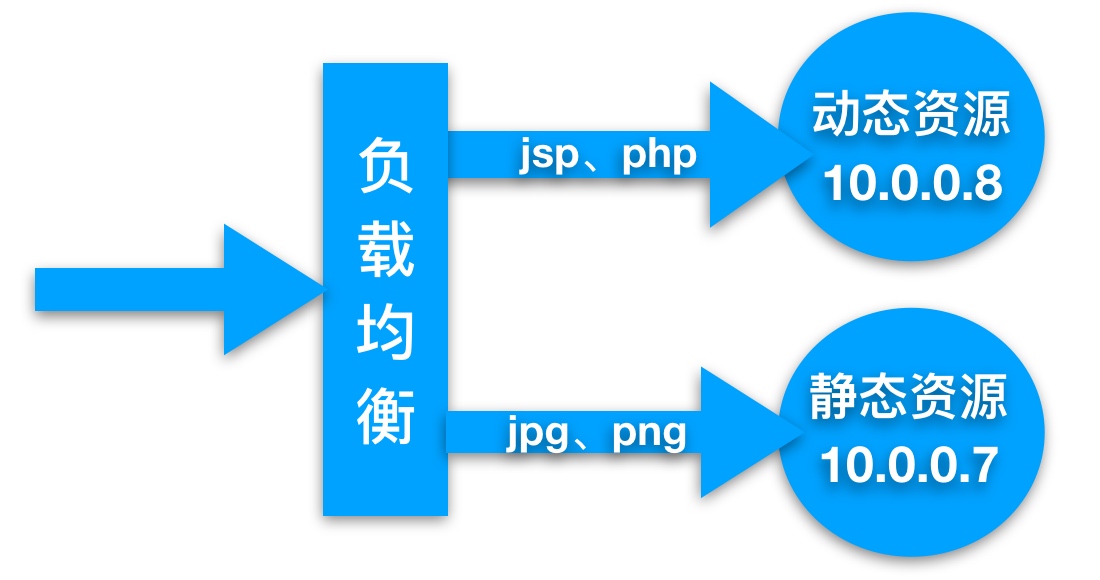
Nginx动静分离实践应用案例
0.环境准备
| 系统 | 服务 | 服务 | 地址 |
|---|---|---|---|
| CentOS7.5 | 负载均衡 | Nginx Proxy | 10.0.0.5 |
| CentOS7.5 | 静态资源 | Nginx Static | 10.0.0.7 |
| CentOS7.5 | 动态资源 | Tomcat Server | 10.0.0.8 |
1.在10.0.0.7服务器上配置静态资源
[root@web01 conf.d]# cat ds_oldboy.confserver{listen 80;server_name ds.oldboy.com;root /soft/code;index index.html;location ~* .*\.(png|jpg|gif)$ {root /soft/code/images;}}# 准备目录, 以及静态相关图片[root@web01 ~]# mkdir /soft/code/images -p[root@web01 ~]# wget -O /soft/code/images/nginx.png http://nginx.org/nginx.png[root@web01 ~]# systemctl restart nginx
2.在10.0.0.8服务器上配置动态资源
[root@web01 ~]# yum install -y tomcat[root@web01 ~]# mkdir /usr/share/tomcat/webapps/ROOT[root@web01 ~]# vim /usr/share/tomcat/webapps/ROOT/java_test.jsp<%@ page language="java" import="java.util.*" pageEncoding="utf-8"%><HTML><HEAD><TITLE>JSP Test Page</TITLE></HEAD><BODY><%Random rand = new Random();out.println("<h1>Random number:</h1>");out.println(rand.nextInt(99)+100);%></BODY></HTML>#重启tomcat服务[root@web01 ~]# systemctl start tomcat
3.在负载均衡10.0.0.5上配置调度, 实现访问jsp和png
root@lb01 conf.d]# cat ds_proxy.confupstream static {server 10.0.0.7:80;}upstream java {server 10.0.0.8:8080;}server {listen 80;server_name ds.oldboy.com;location / {root /soft/code;index index.html;}location ~ .*\.(png|jpg|gif)$ {proxy_pass http://static;include proxy_params;}location ~ .*\.jsp$ {proxy_pass http://java;include proxy_params;}}[root@lb01 conf.d]# systemctl restart nginx
4.通过负载测试访问静态资源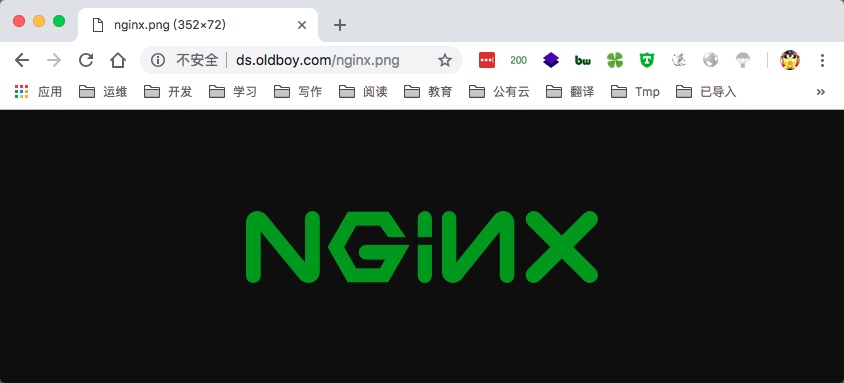
5.通过负载测试访问动态资源
6.在负载均衡10.0.0.5上整合动态和静态资源的html文件
[root@lb01 ~]# mkdir /soft/code -p[root@lb01 ~]# cat /soft/code/index.html<html lang="en"><head><meta charset="UTF-8" /><title>测试ajax和跨域访问</title><script src="http://libs.baidu.com/jquery/2.1.4/jquery.min.js"></script></head><script type="text/javascript">$(document).ready(function(){$.ajax({type: "GET",url: "http://ds.oldboy.com/java_test.jsp",success: function(data) {$("#get_data").html(data)},error: function() {alert("fail!!,请刷新再试!");}});});</script><body><h1>测试动静分离</h1><img src="http://ds.oldboy.com/nginx.png"><div id="get_data"></div></body></html>
7.测试动态和静态资源是否能正常加载在一个html文件中
8.当使用systemctl stop nginx停止Nginx后, 会发现静态内容无法访问, 动态内容依旧运行正常
9.当使用systemctl stop tomcat停止tomcat后, 静态内容依旧能正常访问, 动态内容将不会被请求到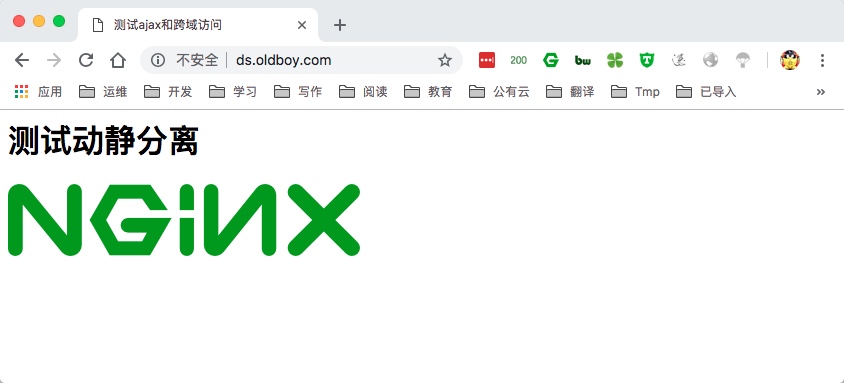
3.Nginx资源分离场景实践
Nginx通过负载均衡实现手机与PC调度至不同的后端节点应用案例
1.根据iphone、安卓、pc跳转不同的页面环境规划
| 系统版本 | 主机角色 | 外网IP | 内网IP | 提供端口 |
|---|---|---|---|---|
| CentOS7.5 | 负载均衡 | 10.0.0.5 | 172.16.1.5 | 80 |
| CentOS7.5 | 提供Android页面 | 172.16.1.7 | 9090 | |
| CentOS7.5 | 提供Iphone页面 | 172.16.1.7 | 9091 | |
| CentOS7.5 | 提供pc页面 | 172.16.1.7 | 9092 |
2.配置后端WEB节点的Nginx配置
[root@web01 conf.d]# cat sj.confserver {listen 9090;location / {root /code/android;index index.html;}}server {listen 9091;location / {root /code/iphone;index index.html;}}server {listen 9092;location / {root /code/pc;index index.html;}}
2.为后端WEB节点配置对应的网站目录以及代码
[root@web01 conf.d]# mkdir -p /code/{android,iphone,pc}[root@web01 conf.d]# echo "PC" > /code/pc/index.html[root@web01 conf.d]# echo "Iphone" > /code/iphone/index.html[root@web01 conf.d]# echo "Android" > /code/android/index.html#检查语法并重载Nginx服务[root@web01 conf.d]# nginx -t[root@web01 conf.d]# systemctl restart nginx
2.配置负载均衡服务,根据不同的浏览器调度到不同的资源池
[root@lb01 conf.d]# cat sj_proxy.confupstream iphone {server 172.16.1.7:9091;}upstream android {server 172.16.1.7:9090;}upstream pc {server 172.16.1.7:9092;}server {listen 80;server_name sj.oldboy.com;location / {#默认跳转至pc站点proxy_pass http://pc;include proxy_params;#如果客户端是Iphone则跳转到iphone的资源池if ($http_user_agent ~* "Iphone") {proxy_pass http://iphone;}#如果客户端是Android则跳转到android的资源池if ($http_user_agent ~* "Android"){proxy_pass http://android;}#如果客户端是IE浏览器,则返回403错误。if ($http_user_agent ~* "msie"){return 403;}}}
3.直接使用浏览器访问,返回默认的结果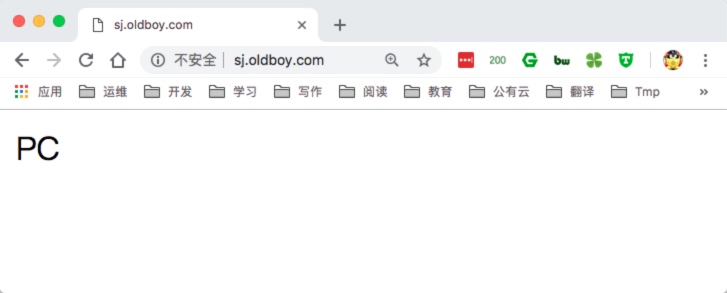
4.如果通过android设备访问,效果如下。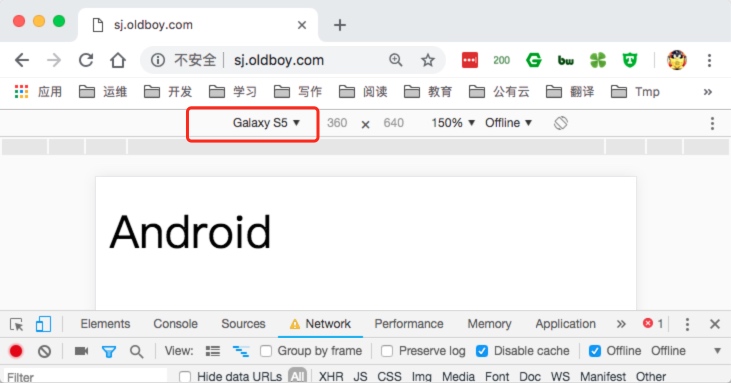
4.如果通过Iphone设备访问,效果如下。